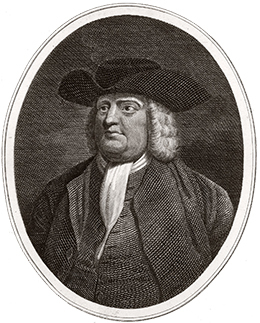| << Chapter < Page | Chapter >> Page > |
The Restoration colonies also included Pennsylvania, which became the geographic center of British colonial America. Pennsylvania (which means “Penn’s Woods” in Latin) was created in 1681, when Charles II bestowed the largest proprietary colony in the Americas on William Penn ( [link] ) to settle the large debt he owed the Penn family. William Penn’s father, Admiral William Penn, had served the English crown by helping take Jamaica from the Spanish in 1655. The king personally owed the Admiral money as well.

Like early settlers of the New England colonies, Pennsylvania’s first colonists migrated mostly for religious reasons. William Penn himself was a Quaker, a member of a new Protestant denomination called the Society of Friends. George Fox had founded the Society of Friends in England in the late 1640s, having grown dissatisfied with Puritanism and the idea of predestination. Rather, Fox and his followers stressed that everyone had an “inner light” inside him or her, a spark of divinity. They gained the name Quakers because they were said to quake when the inner light moved them. Quakers rejected the idea of worldly rank, believing instead in a new and radical form of social equality. Their speech reflected this belief in that they addressed all others as equals, using “thee” and “thou” rather than terms like “your lordship” or “my lady” that were customary for privileged individuals of the hereditary elite.
The English crown persecuted Quakers in England, and colonial governments were equally harsh; Massachusetts even executed several early Quakers who had gone to proselytize there. To avoid such persecution, Quakers and their families at first created a community on the sugar island of Barbados. Soon after its founding, however, Pennsylvania became the destination of choice. Quakers flocked to Pennsylvania as well as New Jersey, where they could preach and practice their religion in peace. Unlike New England, whose official religion was Puritanism, Pennsylvania did not establish an official church. Indeed, the colony allowed a degree of religious tolerance found nowhere else in English America. To help encourage immigration to his colony, Penn promised fifty acres of land to people who agreed to come to Pennsylvania and completed their term of service. Not surprisingly, those seeking a better life came in large numbers, so much so that Pennsylvania relied on indentured servants more than any other colony.
One of the primary tenets of Quakerism is pacifism, leading William Penn to establish friendly relationships with local native peoples. He formed a covenant of friendship with the Lenni Lenape (Delaware) tribe, buying their land for a fair price instead of taking it by force. In 1701, he also signed a treaty with the Susquehannocks to avoid war. Unlike other colonies, Pennsylvania did not experience war on the frontier with native peoples during its early history.

Notification Switch
Would you like to follow the 'U.s. history' conversation and receive update notifications?